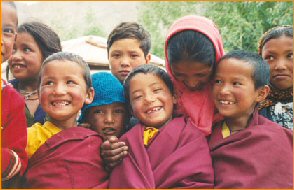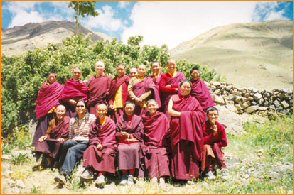|
The First Nuns of Spiti
Buddhism began in India, but died out over the centuries in all but the most remote and inaccessible Himalayan regions of the country, such as Assam, Zanskar, Ladakh, and Spiti. Spiti, a desolate region surrounded by high Himalayan peaks, is a place where people have struggled hard to preserve their unique cultural heritage and environment up to the present day.
Due to heavy snowfalls and other natural impediments, transport and communications to Spiti are impossible much of the year. Economic hardship, particularly disruption of the wool trade from occupied Tibet, has led the men of Spiti to seek jobs in Indian cities. Women now shoulder a heavy responsibility for both family and livelihood at home.
Traditional values are still strong in Spiti, deriving from a unique Buddhist
culture which has been sustained for over 1000 years.
Loving kindness and care for the young, old, and infirm has been the core of women's spiritual practice
there over the centuries. Intense cold and high winds prevail outdoors, so
handicrafts and Buddhist practice--meditation, teachings, and prayer--are
favorite winter activities.
The solace of these spiritually-enriching activities
helps offset the sufferings of the harsh environment.
|
|

Young nuns of Yangchen Choling, Spiti
|
Traditionally women's work has centered around the home--spinning, knitting handcrafted clothing, and caring for the family, animals, and fields. Women's education and spirituality have also centered around the home. Rarely, however, have women emerged as spiritual leaders, due to a lack of educational opportunities. Although Buddhist culture has flourished here since the 8th century, there has never been a traditional learning center for women.
To address this problem, two monastic schools for nuns have been established in the snowy land of Spiti. The first monastery ever established for nuns in Spiti began in 1988 when a group of courageous young women from Pangmo village took the initiative to establish Yangchen Choling as a traditional and contemporary learning center for women. Originally the nuns stayed in caves above the village, but scorpions and space limitations forced them to relocate. The nuns are now struggling to build teachers' quarters, classrooms, and student housing with their own hands. The monastery is now located somewhat below the caves on a plain.

Nuns of Pin Valley, Spiti,
plan a new monastery
|
|
The work of establishing schools has not been easy for the women of Spiti. Plagued by poverty, they face many social and personal obstacles. Girls are often kept at home to work instead of receiving schooling. Gradually, however, through sheer determination, these obstacles are being overcome. Girls are increasingly attending Indian government schools, and just six kilometers away from Yangchen Choling, in the village of Morang, a second innovative education and training program for women--Sherab Choling--was established in 1995. His Holiness the Dalai Lama personally visited and blessed both schools in the summer of 1996.
|
These schools are unique in combining women's spirituality and practical skills that will help the women become economically self-sufficient. Programs that provide training in Buddhist culture, languages, philosophy, handicrafts, and health care combine the best of traditional and modern education.
With diligence and dedication, these women are struggling to overcome their educational, social, and economic disadvantages. With increased confidence and training, they are becoming leaders and spiritual guides in their communities, making valuable contributions toward cultural preservation, environmental protection, health, and community development.
With the Tibetan border now sealed and access to their cultural heartland denied, the threat of cultural extinction in Spiti looms large. Social and economic changes seriously endanger traditional values. Open to tourists only since 1991, Spiti is now vulnerable to the influences of economic exploitation, consumerism, and cultural erosion from both east and west. It is now more urgent than ever that women be granted equal social and educational opportunities to stave this incursion and to stabilize their culture.
Women are now ready to take leadership roles in these remote Himalayan villages faced by poverty and illiteracy. Womens' contributions toward both spiritual and community development are welcome in these barren, economically depressed, and culturally endangered areas. Undaunted by unimaginable hardships and disappointments, the nuns of Spiti bravely persevere.
Himalayan women wish to become economically self-sufficient and play a major role in preserving and transmitting their unique cultural traditions. Many needy young women are desperate for admission, but must wait until more facilities can be built. Increased opportunities for both modern and traditional learning will enable them to benefit their communities and to fulfill their spiritual and intellectual potential. Their progress in the past few years indicates that this dream can be realized.
Health
There is a hospital in Kaza, the district capital. Since Spiti is considered a “tribal area” by the Indian government, prescriptions at the hospital pharmacy are sold for a nominal donation, i.e., whatever change you have in your pockets. There are two regular doctors at the hospital. Locals call one the “good doctor” and one the “bad doctor;” so it’s best to ask before you go! Volunteers report that the “good doctor” is, in fact, good.
Language
The local language is Spitian, also called "Spiti language". It is similar to Tibetan. In Spiti, Tibetan will be more useful to you than Hindi or Urdu, especially with the nuns.
Post
Letters can take about one month each way. Service fluctuates, and some letters never arrive. Mailing addresses for the projects are:
Yangchen Choling Monastery
Village Pangmo, P.O. Hull
Lahaul/Spiti, Himachal Pradesh 172 114
India
Sherab Choling Institute
Village Morang, P.O. Hull
Lahaul/Spiti, Himachal Pradesh 172 114
India
Weather
In summer, the days are usually sunny and warm. The nights get cold, but not freezing. It rarely rains in Spiti.
Miscellaneous
The Spiti monasteries are about a day’s journey further from the new monastery in Kinnaur, and are situated just six kilometers apart. There is only one paved road in Spiti. The monasteries are right next to this road.
Dorje Tsering, who built the two monasteries in Spiti and manages their education projects, speaks English and is extremely helpful. He lives in Hull, midway between the two monasteries, where he has built Pensem Handicraft Center and is starting a dairy project. The monk who teaches philosophy at Sherab Choling Institute in Morang, Gen Tsering Dhondrup, speaks English fluently.
Yangchen Choling has a furnished cave for teachers to sleep in! The cave was repaired in August 1999 and is great for a quiet retreat. Tara Krajanek, an Austrian volunteer, has stayed in the cave several times. Jennifer Lane will stay there during the summer of 2003
If you stay in private homes along the way, it is courteous to offer Rs. 50 per day as a donation. Give this discreetly to the hostess upon departure and say it is for the kids (Tibetan: pugu, Hindi: bacha).
Travel
Spiti can be reached by road only from Shimla until July. Starting in late June, the snow melts around Kunzum-la and Rohtang passes, and the schools are accessible from Manali. The road closes again sometime in September. Be prepared for possible delays on both roads. Sometimes there are avalanches and mud slides that block the roads for up to a week. Even so, it is often possible to walk over the slides and try to get transport on the other side to your destination.
If the Rothang and Kuzum-la passes are open (after July), it is easiest to take the bus to Manali, then travel from there. The bus to Spiti leaves Manali bus station about 5 am and takes all day to get to our monasteries. Take water, juice, and snacks.
If the passes are not open, take a train or bus to Shimla. There you need to apply for an innerline permit at the District Commissioner’s Office or through a travel agent. The permit is required for travel through Upper Kinnaur, since this part of India is close to Tibet. Check your guidebook for the latest version of the permit application process. Bring several passport photos, and a photocopy of your passport and Indian visa to speed things up. It may be best to appear as a tourist going sightseeing, rather than a volunteer at a monastery, since the government does not allow foreigners to work in India. You may need to consult a travel agent and go as part of a makeshift tour group to get the permit, but once you are in, you can travel on your own.
The bus to Spiti is very cheap. It takes you to Rekhong Peo or Tabri the first day, and to Tabo or Kaza the second day. There is generally only one bus a day from any of these towns, leaving very early in the morning; you can ask for the departure schedule at the bus stand as soon as you arrive. You can disembark in Kaza for a rest in a hotel, or continue on the same bus to our monasteries in Pangmo and Morang. Sherab Choling, in Morang, is less than an hour out of Kaza. Just six km. away from Sherab Choling is Yangchen Choling Monastery in Pangmo village.
The trip by jeep from Shimla to Morang or Pangmo is much faster and more comfortable than the bus. It costs $150 to $200. Tea and soft drinks are available along the way, but food is dicey (risky or not available), so bring snacks.
Have a safe trip!
|

